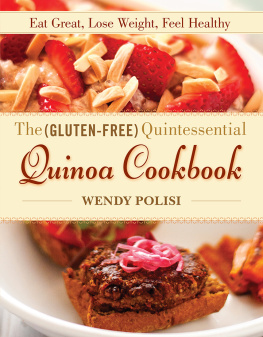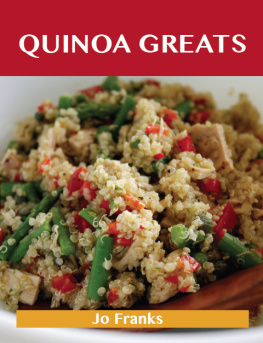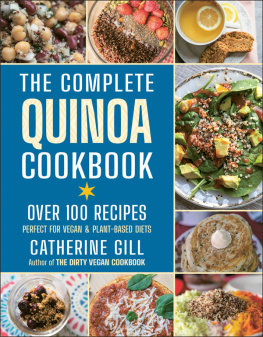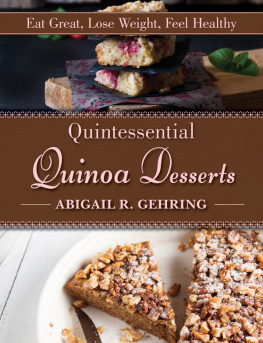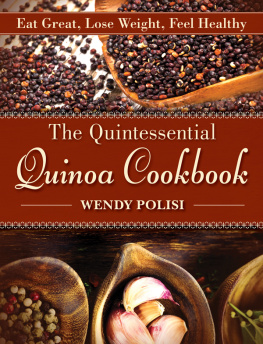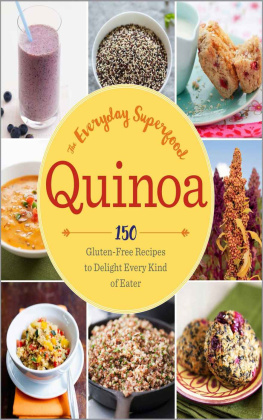Table of Contents
For Chip, Sadie, and Gillian, my all-time favorite dining companions.
JH
In loving memory of my grandmother Agnes, who taught me how to cook.
KS
Introduction
In a time when the term superfood is bandied about with alacrity, its worth noting that quinoa is truly deserving of that designation. Its been said that quinoa is one of the few foods that can provide nearly all the nutrients essential for life. Because quinoa is so nutritious, NASA has even done research on its viability as a crop to cultivate in space.
Although quinoa (pronounced KEEN-wah ) is enjoying a surge in popularity because its so healthful and versatile, its certainly nothing new. In fact, quinoa has a lengthy and dramatic history.
The ancient Incans revered quinoa, referring to it as gold or the mother crop. With great ceremony, the Incan leader planted the first seeds each year using a golden shovel, and celebrations surrounded the harvest. In the Andean mountain region of what is now parts of Peru, Bolivia, Ecuador, Argentina, and Chile, quinoa was important both for sustenance and as part of the cultureuntil Spanish explorer Francisco Pizarro destroyed the fields and declared quinoa illegal in the effort to conquer the Incans. Quinoa very nearly vanished along with the Incan civilization.
Luckily, wild quinoa survived in the mountains of Peru and Bolivia, and some was cultivated for personal use by small-scale farmers far away from the Spanish-occupied area. By 1825, after the Spanish American countries had won their independence and quinoa was no longer illegal, it was still considered the food of the poor and provincial. Even today many South Americansparticularly young Bolivianslook down on quinoa, preferring new cultivated grains introduced by the Europeans, such as wheat.
The California-based Quinoa Corporation (which today sells quinoa under the brand Ancient Harvest) introduced quinoa commercially to Americans in the late 1980s, and the National Association of Quinoa Producers was formed in Bolivia in 1983 to help organize the quinoa supply chain. Today there are about fifty importers of quinoa in the United States, along with a handful of domestic producers. In recent years quinoa has been rediscovered as a valuable grain for its high nutritional value and its hardiness (quinoa has been known to surviveand even thriveduring major droughts that have wiped out other crops). American and European foreign-aid organizations have been helping farmers in South America cultivate quinoa for exportation.
What Is Quinoa?
Although quinoa often gets classified as a grain, like wheat and barley, its actually in the goosefoot family, related to beets, spinach, and chard. The seed of the plant is whats most commonly consumed. (The leaves also can be eaten, but theyre not commonly found in U.S. stores.) Nutritionists refer to quinoa as a pseudograin (along with amaranth and buckwheat) because it has a similar nutritional profile to true grains and is prepared and served in similar ways.
Most of the worlds supply of quinoa is still grown in the Andes region of South America, although the plant is starting to be cultivated in the United States and Canada, in mountainous areas that have similar cold and dry conditions.
Quinoa plants are bushy stalks that can grow as tall as nine feet, with large seed heads. There are hundreds of known varieties, but the most commonly available are white, red, and black. The quinoa seeds are covered in saponin, a bitter coating that agriculturists believe helps protect the seeds from insects and birdsmaking quinoa a particularly easy crop to grow without the use of chemical pesticides. Quinoa processors typically use either a water bath or mechanical abrasion to remove the saponin.
Quinoas Health Benefits
Quinoa has a nutritional profile that few other plant products can match. You can reap some of these nutritional benefits by substituting the seeds for less nourishing foods. Use quinoa instead of white rice or couscous in pilafs, for example, or incorporate quinoa flour or flakes into baked goods in place of all or part of the wheat flour.
According to NutritionData.com, one serving of quinoa (185 grams or 6 1/2 ounces) has the following nutritional content, as compared to the same volume of white rice and pearled barley:
Here are some of the nutritional benefits youll enjoy by making the quinoa recipes in this book:
Quinoa is rich in protein, calcium, iron, fiber, and potassium (which helps control blood pressure), and it is a good source of B vitamins and vitamin E. Its considered a complete protein because it provides a healthy balance of all eight essential amino acids, one of the few plant foods that does so.
The germ in quinoa seeds makes up about 60 percent of the grain, yielding a high ratio of protein to carbohydrates. Quinoa is higher in protein than rice, corn, or wheat, and higher in fiber than corn or wheat. This nutritional profile means that quinoa can help you feel full longer than many other foods, making it ideal for trying to maintain a healthy weight.
People with celiac disease and others who are sensitive to gluten, wheat, and other grass-based food products will find quinoa useful because it is gluten-free. Quinoa contains more antioxidants than gluten-free products made with rice, corn, or potato, so incorporating quinoa flour into gluten-free baked goods gives them a big nutritional boost.
Research has also shown that quinoa may be useful in preventing certain diseases. Because its rich in the antioxidant quercetin, it may be helpful in managing type-2 diabetes and associated hypertension. In one study, quinoa was shown to reverse certain adverse effects of a high-fructose diet on lipids and glucose levels in lab animals.
Types of Quinoa and Quinoa Products
There are a number of quinoa types and products on the market. Here are the most common:
White Quinoa Also called ivory or yellow quinoa, this is the most readily available type of quinoa, sold in most supermarkets in the natural foods section. Some people describe the flavor as nutty. White quinoa has the mildest flavor of all the varieties and is neutral enough to take on the flavors of other ingredients. The texture of cooked white quinoa can be al dente (with a slight firmness, like pasta) or slightly mushy, depending on how long its cooked and in how much liquid. This is typically the least expensive type of quinoa.
Red Quinoa A beautiful mahogany red, this quinoa has a nuttier flavor than the white type, and a slightly chewier texture. It makes a great accent, in terms of both color and texture, in stews or other longer-cooked recipes, as it holds its shape and firmness better than white quinoa. Red quinoa is a little more difficult to find than white and can be pricier. Look for it online or in specialty or natural food stores.
SPROUTING QUINOA
Sprouting quinoa is easy, and its believed to boost some of the seeds health benefits. Quinoa sprouts can be added to salads, sandwiches, and an array of other cold dishes. Rinse the quinoa, rubbing it between your fingers to remove any remaining saponin. Place in a shallow dish and add enough water to cover the quinoa by at least 1 inch. Cover the dish with a clean dish towel and let stand at room temperature for 45 minutes to 1 hour. Then place the quinoa in a strainer, gently rinse, and drain off the excess water. Return the quinoa to the shallow dish and spread in an even layer. Cover with a clean dish towel and place in a cool, dark place for 8 to 12 hours.



